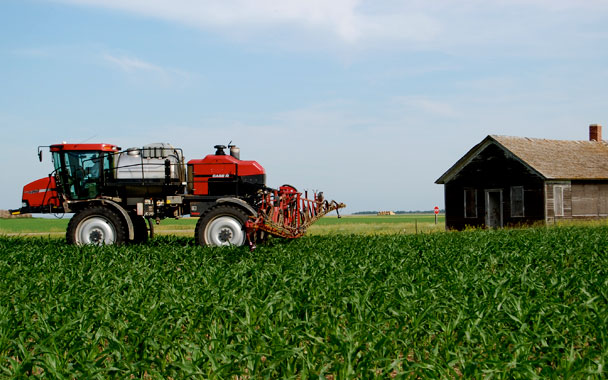Exhaustion breeds indifference. Everyone in eastern South Dakota is tired of talking about the weather. A tornado rumbled through last week, 30 miles west of Dale Hargens, and he doesn’t even mention it. He has just finished two solid weeks of sunrise-to-sunset wheat combining. He’s tired and happy. He still thinks his best cornfields will yield a record 200 bushels an acre, and overall the farm will average 150 bushels. “The beans look fabulous. Fifty bushels an acre. Those are Iowa yields.” It’s time to take a few days off. He’s going to Mitchell to the farm show. “Just looking,” he says. “Like a kid in a toy store just before Christmas. I’ve got a wish list. Maybe some new heads for the combine and some harvest equipment.”
Up in Brown County, Scott Christenson is mowing weeds around the edges of his fields and trying to find time for a few rounds of golf. “Once we get past Labor Day, there won’t be any time to relax. We’ll be getting into the corn harvest,” he says.
In the midst of the calm, two headlines hit the newspapers, illustrating the great paradox of industrial commodity farming on the Great Plains.
Marine biologists announce that the “dead zone” in the Gulf of Mexico is 8,500 square miles. Nothing can live in the oxygen-starved waters of the dead zone: no seafood, no nothing. The dead zone has strangled the seafood economy of the Louisiana and Texas coasts and destroyed the region’s ecological diversity. The cause? High nitrogen-fertilizer runoff from the agricultural lands of the sprawling Mississippi River floodplain. From Crow Creek and Wolf Creek into the James River, into the Missouri, and down the Mississippi to the Gulf of Mexico. Even The New York Times steps in to editorialize that “there is no better symbol of the paradox of American agriculture—the very richness applied to the fields is the source of ecological death hundreds of miles away.” Hargens is quick to explain that his high yields are the result of being “very aggressive” about fertilizer applications and pesticide control. But he has no way of calculating his contribution to the dead zone, and federal farm policy offers neither incentives to farm a different way, nor sanctions to slow down or limit his use of fertilizer. He makes individual choices about his private farmland disconnected from the public consequences almost 1,500 miles away.
The second headline, which earns more comments in the local coffee shops, is about the USDA’s midsummer crop report, which concludes that Iowa has bounced back from its spring flooding and the national corn crop will be enormous. Corn futures immediately respond by dropping below the $5.50 mark, lower than they have been all summer and more than $2 a bushel lower than the high market in late June. “We are our own worst enemies,” Hargens concludes. “We make the most money when we grow the biggest crop. But big crops make the price go down.”
Both Hargens and the Christenson brothers have plowed up pasture over the last few years, and expanded their corn acreage. Hargens plowed up 200 acres and planted it to sunflowers. The Christensons planted 500 acres to corn. All around them neighbors are doing the same. With commodity prices booming, who wouldn’t? They are not plowing native prairie, just old Depression-era “blowout” farms that were planted to brome cheatgrass and crested wheat in the ’30s and ’40s to stabilize the soil, and have reverted to pasture over the years. As Hargens notes, “If we farmed the way we used to in the 1930s, we’d have dust storms all over the place. But with ‘no-till’ techniques we don’t have wind storms from erosion, and the wildlife and birds love the old stubble from last year’s crops.” Scott Christenson adds that he and his brother worked with the Natural Resources Conservation Service for five years to plan the plow-up of their old farm.
And yet, between those two farms, 500 new acres have been added to corn production and 200 to sunflowers. Those 700 new acres have been treated with fertilizer and pesticides. Those 700 new acres have been taken out of pheasant-breeding grounds. And 700 acres have been taken out of cattle pasture. Many experts believe that the conversion of pasture to cropland has had a big impact on the sell-off of breeding herds over the last few years.
On the scale of the northern Plains, remote from New Orleans, remote even from the Mississippi, it is hard to imagine that the decisions of one or two farmers can have any impact at all. But the individual decisions of 10,000 farmers, each pursuing his own self-interest, added together, can make a dead zone in the Gulf of Mexico the size of Massachusetts.


